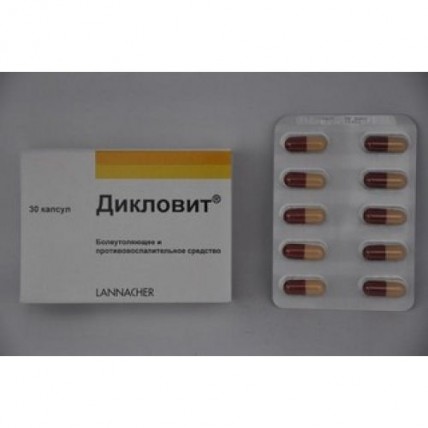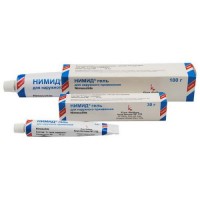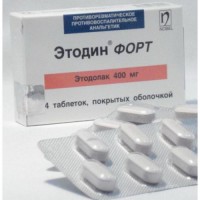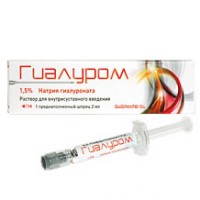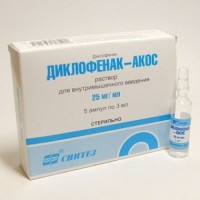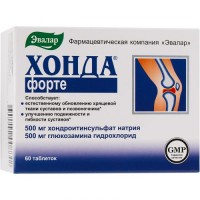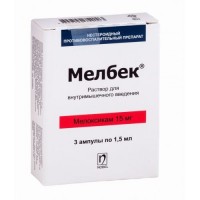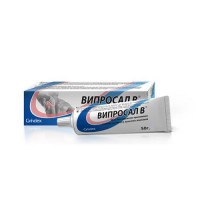The instruction for medical use of Diklovit® medicine the Trade name of Diklovit® the International unlicensed name Is not present the Dosage form of the Structure One Capsule Capsule active substance-diclofenac of sodium of 50 mg, excipients contains Granulate: povidone, methacrylic acid – ethyl acrylate % copolymer (1:1) 30 dispersiya1, triethyl citrate, talc, Powder active agents: thiamine a hydrochloride of 50 mg, a pyridoxine a hydrochloride of 50 mg, cyanocobalamine (from 20% surplus) 0.25 (0.30) mg, excipient - povidone. Structure of a cover of the Body capsule: titan dioxide (E171), ferrous oxide red (E172), ferrous oxide yellow (E172), gelatin Lid: the titan dioxide (E 171), ferrous oxide red (E 172), gelatin 1 18.67 of mg of suspension corresponds to 5.60 mg of dry matter the Description Solid gelatin capsules of 1 in size, with the body of color of ivory and a lid of color Swedish orange. Capsule contents - mix of powder of pink color and granulate of white color, with B1 vitamin smell. Pharmacotherapeutic group Non-steroidal anti-inflammatory drugs. Acetic acid derivatives. Diclofenac in a combination with other drugs ATX M01AB55 Code Pharmacological Pharmacokinetics At Properties Diklovit's reception inside diclofenac is quickly and completely soaked up from digestive tract. Diclofenac is exposed to metabolism in a liver at the first passing, about 50% of the drug taken inside come to a system blood stream. The maximum concentration in plasma is reached in 1-2 h. Communication with proteins of plasma exceeds 99%. Drug well gets into fabrics and that is especially important, in synovial fluid where its concentration grows more slowly, than in plasma, but reaches higher values. Elimination half-life of diclofenac of plasma makes about 2 h, of synovial fluid - 3-6 h. With urine about 60% of a dose in the form of metabolites and less than 1% in not changed look are removed, about 30% of drug are removed with a stake. The age and also a condition of function of kidneys and a liver have no significant effect on pharmacokinetic parameters of diclofenac. The vitamins which are Diklovit's part are water-soluble that excludes a possibility of their cumulation in an organism. Thiamine and a pyridoxine are soaked up in an upper part of a small intestine, metabolized in a liver and removed by kidneys (about 8-10% - in not changed look). Extent of absorption depends on a dose, at overdose the removal of thiamine and a pyridoxine through intestines considerably increases. Absorption of cyanocobalamine depends to a large extent on existence in an organism of an internal factor (in a stomach and an upper part of a small intestine), further delivery of vitamin B of fabric is defined by transport protein transcobalamine. After metabolism in a liver cyanocobalamine is removed generally with bile, extent of removal by kidneys is variable - from 6 to 30%. The pharmacodynamics Diclofenac of sodium causes analgetic, anti-inflammatory and febrifugal action of Diklovit. The mechanism of effect of diclofenac is connected with oppression of synthesis of prostaglandins. Thiamine (B1 vitamin) in a human body as a result of processes of phosphorylation turns into cocarboxylase which is a coenzyme of many fermental reactions. B1 vitamin plays an important role in carbohydrate, proteinaceous and lipometabolism. Actively participates in processes of carrying out nervous excitement in synapses. The pyridoxine (B6 vitamin) is necessary for normal functioning of the central and peripheral nervous system. In a fosforilirovanny form is a coenzyme in metabolism of amino acids (decarboxylation, transamination, etc.). Acts as a coenzyme of the major enzymes operating in nervous tissues. Participates in biosynthesis of many neurotransmitters - such as dopamine, serotonin, noradrenaline, adrenaline, histamine and GAMK. Cyanocobalamine (B12 vitamin) is necessary for a normal hemopoiesis and maturing of erythrocytes and also participates in a number of the biochemical reactions providing activity of an organism - in transfer of methyl groups, in synthesis of nucleic acids, protein, in exchange of amino acids, carbohydrates of lipids. Has beneficial effect on processes in nervous system (synthesis of nucleic acids and lipidic composition of cerebrosides and phospholipids). Coenzymatical forms of cyanocobalamine - methylcobalamine and adenozilkobalamin are necessary for replication and growth of cells. Indications Inflammatory and degenerative forms of rheumatic diseases: - chronic polyarthritis - an ankylosing spondylitis (Bekhterev's disease) - arthrosis - a spondylarthritis - acute gouty arthritis - neuritis and neuralgia, such as cervical syndrome, a lumbago, the ischialgia should accept the Route of administration and doses of the Capsule at meal time, without chewing and washing down with enough liquid. Usually appoint on 1 capsule 1-3 times a day. The adult Diklovit appoint on 1 capsule - in an initiation of treatment 2-3 times a day, as a maintenance dose - 1-2 times a day. The maximum daily dose should not exceed 3 capsules. Duration of a course of treatment, depending on a nosology and disease severity, is established by the doctor. Patients of advanced age. Though the pharmacokinetics of diclofenac does not depend on age, patients of advanced age should select a dose with care. Side effects are included In the following list of undesirable effects effects about which it was reported in connection with use (both short-term, and long-term) the drug Diklovit or other dosage forms of diclofenac: Side reactions are distributed in the following order, taking into account emergence frequency: very often (≥1/10), it is frequent (≥1/100 to & lt, 1/10), sometimes (≥1/1000 to & lt, 1/100), is rare (≥1/10000 to & lt, 1/1000), is very rare (& lt, 1/10000) the Class on defeat of bodies and the systems of bodies Frequency By-effects Infectious and parasitic diseases It was Very seldom reported about temporary communication between use of NPVP and aggravation of infectious inflammatory process. Perhaps, it is connected with the mechanism of action of NPVP. Disturbances from blood and lymphatic system Very seldom the Thrombopenia the Leukopenia Anemia (including hemolytic and aplastic anemia) the Disturbance Agranulocytosis from the immune system Seldom Reaction of hypersensitivity, reaction of anaphylactic type (including hypotension, shock) Very seldom Quincke's disease (including a face edema) Disturbances of mentality Very seldom the Disorientation the Depression Insomnia, nightmares Irritability Psychotic reactions of Disturbance from nervous system Often the Headache Dizziness, fatigue, drowsiness Very seldom Paresthesia Disturbance of memory of the Spasm Feeling of alarm the Tremor Aseptic meningitis Does not know Disturbance of taste of Disturbance of cerebral circulation Prolonged use (over 6-12 months) of the daily doses of B6 vitamin exceeding 50 mg, can cause peripheral touch neuropathy. Disturbances from an organ of sight Sometimes of the Disorder of vision (illegibility of sight, doubling in eyes) Disturbances from an organ of hearing and balance Seldom Passing disorders of hearing Sonitus of Disturbance from heart the Cardiopalmus of Bol in a thorax Heart failure, the Disturbance myocardial infarction Is very rare from vessels Very seldom Arterial hypertension the Disturbance Vasculitis from the respiratory system, bodies of a thorax and mediastinum Seldom Asthma (including an asthma) Very seldom Disturbance Pneumonia from digestive tract Very often Nausea, vomiting, diarrhea Weak bleeding Is frequent Dyspepsia the Abdominal pain the Meteorism Anorexia Seldom Gastritis, a hematemesis, gastrointestinal bleeding, hemorrhagic diarrhea, a melena, gastrointestinal ulcers (with bleeding/perforation or without those) Very seldom Colitis (including hemorrhagic colitis and exacerbation of ulcer colitis or Crohn's disease) the Constipation Stomatitis (including a stomacace), a glossitis of Damage of a gullet Phrenic strictures of intestines (when using oral dosage forms of diclofenac) Pancreatitis It is unknown Ischemic colitis of Disturbance from a liver and biliary tract Often of the Abnormal liver function (increase in serumal levels of transaminases) Sometimes Hepatitis, jaundice, damage of a liver Very seldom Lightning hepatitis Liver Necrosis the Liver failure of Disturbance from skin and hypodermic fabrics Often Rash, an itching Sometimes the Small tortoiseshell Very seldom Bullous rash Eczema, an erythema of Mnogoformnaya an erythema Stephens-Johnson's Syndrome the Toxic epidermal necrolysis (Lyell's disease) Exfoliative dermatitis the Alopecia Reaction of a photosensitization of Purple, an allergic purpura of Disturbance from kidneys and urinary tract Very seldom the Acute liver failure the Hamaturia the Proteinuria the Nephrotic syndrome Interstitial nephrite Necrosis of renal nipples the General disorders and disturbances in the injection site Seldom Swelled In the corresponding situations, patients should recommend to stop reception of capsules Diklovit and to ask immediately for medical care in case of any of the following symptoms of potentially serious side effects: complaints to problems with a stomach, heartburn or an abdominal pain a hematemesis, black color of a chair, blood in urine skin reactions, such as rash or itching the complicated breath, the shortage of breath, edema of face or other parts of the head yellowing of skin or eyes the significant fatigue together with loss of appetite a constant sore throat, ulcers in an oral cavity, exhaustion or heat nasal bleeding, skin bleeding edema of face, legs or a foot decrease in amount of urine against the background of the significant fatigue a heavy headache or constraint of muscles of a neck thorax pain turbidity of consciousness of the Contraindication - hypersensitivity to drug components (including to other non-steroidal anti-inflammatory drugs) - ulcer of stomach and duodenum - the anamnestic data on bleeding, perforation of digestive tract connected with use of acetylsalicylic acid and other non-steroidal anti-inflammatory drugs (NPVP) - intracranial bleedings - Crohn's disease - ulcer colitis - the anamnestic data on attacks of bronchial asthma, urticaria, acute rhinitis connected with use of acetylsalicylic acid and other non-steroidal anti-inflammatory drugs (NPVP) - heavy heart failure - coronary heart disease - a porphyria - disturbance of a hemostasis (including hemophilia), - hemopoiesis disturbances - acute heavy bleeding - a heavy liver failure - a heavy renal failure - pregnancy and the period of a lactation - children's and teenage age up to 18 years Medicinal interactions Simultaneous use of Diklovit with digoxin and drugs of lithium can lead hemorrhagic diathesis to increase in their concentration in plasma. Monitoring, and if necessary, dose adjustment is recommended. At simultaneous use of Diklovit with kaliysberegayushchy diuretics the increase in level of potassium in blood is possible. Diklovit can reduce diuretic effect of loopback diuretics and also reduce hypotensive effect of antihypertensive drugs. Reduces effect of somnolent drugs. Diklovit's combination to other non-steroidal anti-inflammatory drugs and also to glucocorticoids can increase risk of emergence of side effects from digestive tract, in particular, of bleedings. Diklovit can promote increase in toxicity of a methotrexate and also increase in nephrotoxicity of cyclosporine. In certain cases simultaneous use of Diklovit and anticoagulants the risk of developing of bleedings increases. Diklovit increases efficiency of antiagregant. Intake of diclofenac with a zidovudine increases risk of development of hematologic toxicity. The patients taking the oral anti-diabetic drugs along with Diklovit have messages about development, both a hypoglycemia, and a hyperglycemia. For this reason it is recommended to control during therapy glucose level in blood. Simultaneous use of diclofenac and a kolestipol or holestiramin reduces diclofenac absorption approximately by 30% and 60% respectively. The drugs should be taken at an interval of several hours. Drugs which stimulate enzymes for example rifampicin, carbamazepine, Phenytoinum, a St. John's wort (Hypericum perforatum) and others, are theoretically capable to reduce concentration of diclofenac in plasma. Influence of NPVP on synthesis of prostaglandins in kidneys can increase nephrotoxicity of cyclosporine. There are separate messages about development of spasms in patients, the receiving at the same time derivative hinolon and NPVP. At simultaneous use of Diklovit and acetylsalicylic acid the decrease in concentration of diclofenac in blood is possible. Diklovit reduces protivoparkinsonichesky efficiency of a levodopa. Simultaneous use with paracetamol increases risk of development of nephrotoxic effects of diclofenac. Tsefamandol, tsefoperazon, tsefotetan, valproic acid and plikamitsin increase the frequency of development of a prothrombinopenia. Cyclosporine and drugs of gold increase influence of diclofenac on synthesis of prostaglandins in kidneys that increases nephrotoxicity. Co-administration with ethanol, colchicine, corticotropin, inhibitors of the return serotonin reuptake and drugs of a St. John's wort increases risk of developing bleeding in digestive tract. Diclofenac strengthens effect of the drugs causing a photosensitization. The drugs blocking canalicular secretion increase concentration in diclofenac plasma, thereby increasing its toxicity. Ethanol sharply reduces thiamine absorption (level in blood can decrease by 30%). Long-term treatment by anticonvulsant drugs can result in deficiency of thiamine. Use of colchicine and biguanides reduces cyanocobalamine absorption. Effect of thiamine is inactivated 5-ftoruratsily as the last competitively inhibits phosphorylation of thiamine in thiamine pyrophosphate. Antacids reduce thiamine absorption. The loopback diuretics, for example, furosemide braking a canalicular reabsorption at long therapy can cause increase in excretion of thiamine and, thus, reduce thiamine level. The concomitant use with antagonists of a pyridoxine (for example, an isoniazid, gidralazin, Penicillaminum or Cycloserinum), oral contraceptives can increase the need for B6 vitamin. The special instructions Emergence of Side Effects it can be reduced by use of minimum effective dose during the shortest time necessary for control of a symptom. With care it is necessary to use drug at patients with asthma, seasonal allergic rhinitis, a rhinedema (polyps of a nasal cavity), chronic obstructive diseases of lungs or persistent infections of airways (especially if they are connected with the symptoms similar to allergic rhinitis) as they have a risk of development of reactions to NPVP, including exacerbations of asthma (so-called asthma with intolerance of analgetics), a Quincke's edema and urticaria, above, than at other patients. For this reason, it is necessary to approach treatment of such patients with extra care (readiness for rendering the emergency medical care). It concerns also the patients having an allergy to other substances which can be manifested, including, as skin reactions, an itching or urticaria. Appropriate supervision and consultation are demanded by patients with the increased arterial blood pressure in the anamnesis and/or heart failure as at treatment of NPVP it was reported about a delay of liquid and hypostases. To patients with insufficiently controlled arterial hypertension, heart failure, the existing coronary heart disease, peripheral arterial vascular diseases and/or cerebrovascular diseases the treatment by diclofenac is appointed after thorough examination. Similar factors should be considered before administration of drug if the patient is inclined to cardiovascular diseases (for example, arterial hypertension, a lipidemia, diabetes, smoking). Drug is not used in stenocardia. Clinical trials and epidemiological data show that diclofenac use, especially in high doses (150 mg a day) and during the long period can be followed by slight increase of risk of arterial trombotichesky complications (myocardial infarction or a stroke). The care is necessary also at treatment by Diklovit
lny with general diseases of connective tissue, anemia, alcoholism and after extensive surgical interventions. It is necessary to be careful at the patients inclined to bleedings (disturbances of coagulability, thrombocytopenia). Patients of advanced age of Diklovit should appoint in the reduced doses. At long-term treatment by Diklovit it is recommended to control indicators of peripheral blood, function of a liver and kidneys, to conduct a research a calla on presence of blood. Patients with a peptic ulcer of a stomach and duodenum or dispeptic symptoms the anamnesis and patients with diseases of a liver, kidneys, heart failure or arterial hypertension need careful medical control. Gastrointestinal ulcers, bleedings and perforation (which can have a lethal outcome) are characteristic of all NPVP and could be noted during treatment, against the background of precautionary symptoms or in case of their absence, or at patients with the serious gastrointestinal phenomena in the anamnesis. In general such phenomena are most dangerous to patients of advanced age. In some cases, when at patients who accept diclofenac these complications develop, drug needs to be cancelled. Due to the use of NPVP, including diclofenac, it was very seldom reported about heavy, even with a lethal outcome skin reactions, including exfoliative dermatitis, Stephens's syndrome - Johnson and a toxic epidermal necrolysis. The high risk of these reactions exists at the beginning of therapy, and development of these reactions is noted in most cases in the first month of treatment. It is necessary to cancel drug at the first manifestations of skin rash and ulcers of a mucous membrane or any other manifestations of hypersensitivity. Diclofenac thanks to the pharmakodinamichesky properties can mask the symptoms characteristic of infectious and inflammatory diseases. At administration of B12 vitamin the clinical picture and also laboratory analyses in a funicular myelosis or pernicious anemia can lose the specificity. Intake of alcohol and black tea reduces thiamine absorption. Consumption of the drinks containing sulfites (for example, wine) increases thiamine degradation. To patients with new growths, except for the cases which are followed by megaloblastny anemia and deficiency of B12 vitamin it is not necessary to use drug. Features of influence of medicine on ability to run the vehicle or potentially dangerous mechanisms during Diklovit's use reduction in the rate of reaction is possible that should be meant at control of transport and work with mechanisms. The overdose Symptoms Diclofenac does not exist a typical clinical picture of overdose by diclofenac. The overdose can cause such symptoms as vomiting, gastrointestinal bleeding, diarrhea, sonitus and spasms. In case of serious poisoning such reactions as an acute renal failure, damage of a liver, respiratory depression and cyanosis are possible. B1 vitamin Thiamine has wide therapeutic range. Very high doses of thiamine (more than 1 grams) render the blocking effect on a ganglion and, similar to a curare, suppress carrying out nervous impulses. B6 vitamin the Toxic potential of B6 vitamin can be considered very low. However prolonged use (more than 6-12 months) of B6 vitamin in the doses exceeding 50 mg/days can cause peripheral touch neuropathy. Continuous intake of B6 vitamin in doses can result over 1 g/days during the period exceeding 2 months in neurotoxic effects. After intake of B6 vitamin in doses over 2 g/days were reported about neuropathy cases with an ataxy and disturbances of sensitivity, cerebral spasms against the background of changes of EEG and also about very exceptional cases of hypochromia anemia and seborrheal dermatitis. B12 vitamin After parenteral administration of high doses of B12 vitamin (in rare instances also after oral introduction) it was reported about allergic reactions, eczematic changes of an integument and a benign form of acne rash. Treatment: symptomatic and control of the vital functions, gastric lavage, prescribing of activated carbon, artificial diuresis. The form of release and packing On 10 capsules place in blister strip packaging from PVC / PE / PVDH and aluminum foil. On 3 planimetric packs together with the instruction for medical use in the state and Russian languages place in a pack from cardboard. To Store storage conditions at a temperature not above 25 °C, in the dry, protected from light place. To store out of children's reach! A period of storage of 30 months not to use drug after expiry date. Prescription status According to the prescription the Producer G.L. Pharma GmbH., Industriestraße 1, A-8502 Lannach, Austria the Owner of the registration certificate of OOO Valeant, Russia the Name, the address and a contact information (phone, the fax, e-mail) of the organization in the territory of the Republic of Kazakhstan, the accepting claim (offer) on quality of medicines from consumers and responsible for post-registration observation of safety of medicine of TOO Valeant Kazakhstan, 050059, Almaty, Al-Farabi Avenue, Business center Nurly-Tau Block 4B, office 1104 Phone number +7 727 3111 516, + 7 727 329 0045, fax +7 727 3 111 517 E-mail:
To Develop Îffice.KZ@valeant.com
lny with general diseases of connective tissue, anemia, alcoholism and after extensive surgical interventions. It is necessary to be careful at the patients inclined to bleedings (disturbances of coagulability, thrombocytopenia). Patients of advanced age of Diklovit should appoint in the reduced doses. At long-term treatment by Diklovit it is recommended to control indicators of peripheral blood, function of a liver and kidneys, to conduct a research a calla on presence of blood. Patients with a peptic ulcer of a stomach and duodenum or dispeptic symptoms the anamnesis and patients with diseases of a liver, kidneys, heart failure or arterial hypertension need careful medical control. Gastrointestinal ulcers, bleedings and perforation (which can have a lethal outcome) are characteristic of all NPVP and could be noted during treatment, against the background of precautionary symptoms or in case of their absence, or at patients with the serious gastrointestinal phenomena in the anamnesis. In general such phenomena are most dangerous to patients of advanced age. In some cases, when at patients who accept diclofenac these complications develop, drug needs to be cancelled. Due to the use of NPVP, including diclofenac, it was very seldom reported about heavy, even with a lethal outcome skin reactions, including exfoliative dermatitis, Stephens's syndrome - Johnson and a toxic epidermal necrolysis. The high risk of these reactions exists at the beginning of therapy, and development of these reactions is noted in most cases in the first month of treatment. It is necessary to cancel drug at the first manifestations of skin rash and ulcers of a mucous membrane or any other manifestations of hypersensitivity. Diclofenac thanks to the pharmakodinamichesky properties can mask the symptoms characteristic of infectious and inflammatory diseases. At administration of B12 vitamin the clinical picture and also laboratory analyses in a funicular myelosis or pernicious anemia can lose the specificity. Intake of alcohol and black tea reduces thiamine absorption. Consumption of the drinks containing sulfites (for example, wine) increases thiamine degradation. To patients with new growths, except for the cases which are followed by megaloblastny anemia and deficiency of B12 vitamin it is not necessary to use drug. Features of influence of medicine on ability to run the vehicle or potentially dangerous mechanisms during Diklovit's use reduction in the rate of reaction is possible that should be meant at control of transport and work with mechanisms. The overdose Symptoms Diclofenac does not exist a typical clinical picture of overdose by diclofenac. The overdose can cause such symptoms as vomiting, gastrointestinal bleeding, diarrhea, sonitus and spasms. In case of serious poisoning such reactions as an acute renal failure, damage of a liver, respiratory depression and cyanosis are possible. B1 vitamin Thiamine has wide therapeutic range. Very high doses of thiamine (more than 1 grams) render the blocking effect on a ganglion and, similar to a curare, suppress carrying out nervous impulses. B6 vitamin the Toxic potential of B6 vitamin can be considered very low. However prolonged use (more than 6-12 months) of B6 vitamin in the doses exceeding 50 mg/days can cause peripheral touch neuropathy. Continuous intake of B6 vitamin in doses can result over 1 g/days during the period exceeding 2 months in neurotoxic effects. After intake of B6 vitamin in doses over 2 g/days were reported about neuropathy cases with an ataxy and disturbances of sensitivity, cerebral spasms against the background of changes of EEG and also about very exceptional cases of hypochromia anemia and seborrheal dermatitis. B12 vitamin After parenteral administration of high doses of B12 vitamin (in rare instances also after oral introduction) it was reported about allergic reactions, eczematic changes of an integument and a benign form of acne rash. Treatment: symptomatic and control of the vital functions, gastric lavage, prescribing of activated carbon, artificial diuresis. The form of release and packing On 10 capsules place in blister strip packaging from PVC / PE / PVDH and aluminum foil. On 3 planimetric packs together with the instruction for medical use in the state and Russian languages place in a pack from cardboard. To Store storage conditions at a temperature not above 25 °C, in the dry, protected from light place. To store out of children's reach! A period of storage of 30 months not to use drug after expiry date. Prescription status According to the prescription the Producer G.L. Pharma GmbH., Industriestraße 1, A-8502 Lannach, Austria the Owner of the registration certificate of OOO Valeant, Russia the Name, the address and a contact information (phone, the fax, e-mail) of the organization in the territory of the Republic of Kazakhstan, the accepting claim (offer) on quality of medicines from consumers and responsible for post-registration observation of safety of medicine of TOO Valeant Kazakhstan, 050059, Almaty, Al-Farabi Avenue, Business center Nurly-Tau Block 4B, office 1104 Phone number +7 727 3111 516, + 7 727 329 0045, fax +7 727 3 111 517 E-mail:
To Develop Îffice.KZ@valeant.com
